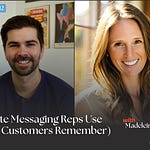Listen now on Spotify, YouTube, and Apple.
On the show today, we have Jeff Chase, Director of Brand and Product Marketing at Vitally.io.
Before joining Vitally, Jeff worked in product marketing and community at places like Plume Design, Verkada, Eero and Amazon.
Jeff’s been a two time founding product marketer at high-growth B2B SaaS start-ups.
In our conversation he shares,
His process to creating positioning and messaging at high growth start ups
The crucial role of customer conversations to develop messaging
Gaining buy-in from leadership for messaging and positioning
How to create effective interactive demos
And so much more!
Key takeaways from the conversation:
Rethinking the Product Marketing Role
Jeff argues that the term product marketing doesn’t do justice to what we actually do. In B2B SaaS, product marketers are core to go-to-market strategy, sales enablement, and positioning.
The title “product marketer” might even be limiting our influence.
Jeff suggests that the best product marketers today operate more like strategic advisors, not just content creators.
So, should we be calling it something else? Time will tell or maybe a little debating will too…
Creating Messaging and Positioning in Startups
Step one for building messaging? Talk to the founders. Not about what the product does, but why it exists.
Focusing on the product's features will come later. You should aim to understand the founders' motivations, like:
Why they built the product.
How they plan to differentiate it in the market.
The pain points they identified.
Their firsthand experiences with these pain points.
When you understand these foundational elements, you can grasp the essence of why the product exists.
This is crucial for building effective messaging that highlights the product's differentiation, especially when entering an existing market. Jeff mentions, in competitive spaces, it's not enough to explain what a product is (like a CRM); you need to tell people why your product is being built the way it is.
The Role of Customer Conversations
You’re never done with customer research.
Messaging should evolve as your customers’ challenges evolve. Jeff shares how he refines messaging at Vitally by constantly listening to sales calls, customer success feedback, and direct interviews.
Reach out to customers within 30 days of starting. Have open-ended conversations to reveal recurring themes and the specific language customers use to describe their problems and what’s been solved so far. This customer language is invaluable for crafting messaging that resonates authentically.
Look to ongoing conversations. These reoccurring conversations are essential for continuously refining your messaging and positioning to remain relevant and impactful. This feedback loop helps prevent your messaging from becoming stagnant.
What biggest takeaway here? The importance of humanizing your message by putting yourself in the shoes of the buyer and understanding their perspective.
Gaining Buy-In for Messaging and Positioning
Rolling out new messaging isn’t about unveiling a finished product—it’s about bringing internal stakeholders along for the journey.
Here’s Jeff’s process for getting buy-in from leadership:
Open the Conversation: Present your positioning and messaging not as a final decision, but as a starting point for discussion and feedback. Frame it as "here's what I'm thinking based on what I've heard," inviting thoughts and feedback to build something everyone can rally behind.
Proof Points: Support your proposed messaging with evidence like quotes from customer interviews and even relevant Reddit posts. Back this up with data from market reports and original research.
Balancing Perspectives: Recognize that founders and leaders have their own vision, and it's crucial to balance that with the realities observed in the market and feedback from customers. If these perspectives are too far apart, a foundational conversation about potential repositioning might be necessary.
Engaging Stakeholders Early: Don't present your messaging as a surprise. Involve key stakeholders from different teams like sales, customer success, and product early in the process to get their input and build alignment. This will helps prevent pushback later on. Getting buy-in from the sales leadership is particularly important as they are on the front lines and often have the ear of senior leadership.
Iterative Testing: View positioning and messaging as something to be tested and refined continuously. Use the sales team to test different messaging (talk tracks, slides decks, etc.) during calls and gather feedback on what resonates.
Brand and Product Messaging Alignment
At early-stage startups, your brand is your product.
Often times, you’ll notice other companies rely heavily on abstract messaging without clearly showing the product in action. We’ve all seen it. Lazy category creation or buzzword messaging.
By making the product essentially the brand, you showcase its value and differentiation directly.
This provides a competitive advantage by reducing the time it takes for potential customers to understand what the software does and how it solves their problems.
In a crowded market, this directness helps stand out and can accelerate customer acquisition by immediately addressing the core question: "What does this product actually do for me?"
As the company grows and the brand becomes more established, the focus might evolve beyond just the product itself.
Creating Effective Interactive Demos
The goal of an interactive demo? Get to the aha moment—fast. People don’t want a guided tour of every button; they want to see how the product solves their problem.
Here are the three types of interactive product demos at Vitally.io:
The primary overall product tour:
This is the most in-depth demo and is designed for individuals who have no prior knowledge of Vitally. The goal is to easily educate them by providing quick, succinct steps explaining what the product is and what different features do. As Vitally is a sales-led product, this tour aims to give users a foundational understanding and vocabulary so they can have more informed conversations with the sales team.
Demos on how to use specific features:
These demos are more detailed-oriented and are created for their existing customers. The purpose is to drive self-service adoption of the different features within the platform. These demos might be harder to understand for someone who has never used the platform before.
Blueprints (dual use case for existing customers and prospects):
These demos came about as Vitally noticed their customers using the product in really great ways. The idea was to turn these customer use cases into interactive product demos to showcase how Vitally can be used or how a user could use it in their own context. These "blueprints" serve a dual purpose by showing prospects the power of Vitally and providing existing customers with ideas and templates on how to further utilize the platform.
How to Know When Messaging Resonates
Directly measuring the impact of messaging can be challenging.
Here are a few indicators of success:
The sales team isn't reporting confusion or lack of understanding from prospects regarding the product's value proposition.
Look at business growth metrics like sales revenue increase, adoption of the featured product, customer retention, and competitive win rates. Success in these areas can indicate that the messaging is effectively attracting and engaging the right audience.
Another insightful metric for a customer success platform like Vitally is Net Revenue Retention (NRR), as it reflects both new revenue and the continued value customers see in the product.
Ultimately, if sales isn’t complaining about the messaging and outputs from product marketing, it suggests what you’ve created is resonating, but that doesn’t mean you can’t make it better :)
Noteworthy Quotes:
"If you’re a product marketer and you're treating positioning and messaging as a check mark versus part of your process, then you're going to fail to evolve and grow your business."
"If your sales team isn't complaining that people aren't understanding your message, then it's probably working."
"In early-stage B2B SaaS, I think brand and product positioning should be one and the same, because you don’t have a ton of flexibility and time to speak on the airwaves."
"When you're really building out an interactive demo, you want to get to those 'aha' moments as quickly as possible. People really don't want to slog through why your product exists—they need to see the value fast."
"Great product marketers aren't just storytellers; they connect the dots between customer insights, competitive intelligence, and sales enablement to drive go-to-market success."
"If you launch messaging and immediately get asked to redo it, that’s a sign it didn’t resonate. A good sign that it's working? Your sales team isn’t asking for changes."
"To get buy-in for messaging, you need to take leaders along for the journey—not just suddenly drop a finished product in their lap and expect them to sign off."
"When creating website messaging for a new product feature, don’t just describe the features—focus on the pain points you solve and why that matters to the customer."
In this episode, we cover:
06:20 The Evolution of Product Marketing Roles
10:11 Creating Messaging and Positioning in Startups
16:05 The Role of Customer Conversations
19:11 Gaining Buy-In for Messaging and Positioning
29:07 The Importance of Sales and Customer Feedback
31:23 Brand and Product Messaging Alignment
35:45 Creating Effective Interactive Demos
43:11 Crafting Compelling Website Messaging
51:07 Measuring Messaging Effectiveness
58:05 Final Thoughts on Messaging and Life Lessons
Referenced:
Zach Messler: https://www.linkedin.com/in/zachmessler/
April Dunford: https://www.linkedin.com/in/aprildunford/
Julien Sauvage: https://www.linkedin.com/in/julien-sauvage/
Vitally: https://www.vitally.io/
Jellyfish: https://jellyfish.co/
Salesforce: https://www.salesforce.com/
Nike: https://www.nike.com/
HubSpot: https://www.hubspot.com/
Eero: https://eero.com/
Google: https://www.google.com/
Gainsight: https://www.gainsight.com/
ChurnZero: https://churnzero.com/
Navattic: https://www.navattic.com/
We’re Not Marketers: https://www.notmarketers.com/
April Dunford’s Positioning Podcast: https://www.positioning.show/
Created by Josh Chronister
I interview the best product marketers and tech companies who create messaging that resonates with their buyers. Come learn from them, so you can hit ‘Publish’ with confidence.














